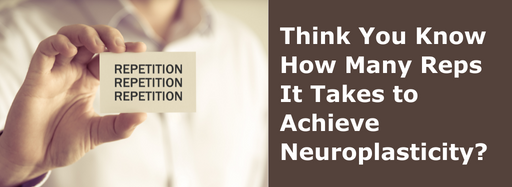Achieving Neuroplasticity: How Many Reps Does It Take?

The damage inflicted by a stroke is unique to every patient, and so is the recovery process. It is not a one-size-fits-all proposition. The brain consists of 100 billion neurons and 200 trillion synapses. It’s nearly impossible to grasp the complexity and power of this amazing organ! During a stroke, 32,000 neurons die every second, totaling around 1.2 billion for the entire event. That’s a lot, but consider the total neurons in the brain, it’s around one percent. That means 99 percent of the brain is still intact! A variety of exercises and movements can be used to provide cues to the brain and achieve neuroplasicity. Thanks to pioneers like Dr. Merzenich, who conducted landmark studies in the 1980’s that confirmed the adult brain is not hard-wired, practitioners have an opportunity to “rewire the brain”.
How Can the Brain be Rewired?
Those cues direct the brain on how to adapt, creating new neural pathways that can overcome any brain damage and alleviate or compensate for physical and mental deficits. This means they can work around the one percent that’s been impacted through neuroplasticity, which can be defined as the ability of the nervous system to change its activity in response to intrinsic or extrinsic stimuli by reorganizing its structure, functions, or connections after injuries, such as a stroke or traumatic brain injury (National Library of Medicine). This “neuroplasticity” was considered impossible a few decades ago. So, why do most traditional stroke therapies fail? They abandon a stroke survivor before this rewiring (neuroplasticity) takes place. Traditional tests which determine if therapy is making an impact do not detect the subtle movements that indicate neuroplasticity is taking place. Fortunately, Merzenich, and others, have offered the clinical community an amazing contribution. As therapists, we must ask ourselves “What did I do during my skilled 45 minutes session to drive neuroplasticity for my patient today?” “Did I do enough?”
How Many Reps is Enough to Achieve Neuroplasticity?
The average number of repetitions performed in a standard therapy session is 30. Yes, 30! We need at least 300-400 reps per session to begin rewiring the brain to provide meaningful outcomes and work towards achieving neuroplasticity. Consider this: There are many studies that show the number of repetitions it takes to “master” a movement. A golf swing, throwing a baseball, ice skating, playing the piano, etc. These repetitions trigger the same rewiring of the brain and require thousands of repetitions. Stroke survivors know that the journey to full recovery can be a long one. It is important to reiterate to them that repetition is key because their brain needs to constantly be reminded how to move a part of the body. With every reminder, connections are reinforced and the ability to successfully complete the action becomes more certain. Each repetition leaves a footprint, a pathway for the next rep to build on and move further towards achieving neuroplasticity – the stage where the brain “remembers” the paths, or new wiring, allowing someone to get better, and keep getting better! With all the exciting new therapy solutions available at our fingertips, now is the time to challenge ourselves to toss out conventional concepts, usually not backed by research (gasp!) and focus on new protocols, supported by science, that produce continuous and lasting results. If you are a stroke survivor or a caregiver, ask your therapist about Dr. Merzenich’s research and read “Soft-Wired: How the New Science of Brain Plasticity Can Change Your Life”.
Takeaways
The longer the brain sits dormant before beginning rehabilitation or the longer a patient waits between rehabilitation sessions, the longer it will take for the brain to establish the necessary connections to drive body parts. The sooner after a stroke event a survivor begins strengthening their brain through neuroplastic exercises (such as performing repetitions or mirror therapy), the quicker they are able to begin reaping the benefits and move towards achieving neuroplasticity. Rewiring the brain takes effort and commitment, and it doesn’t happen overnight, but it does work, providing hope for stroke survivors who’ve been left behind. One rep at a time.
Want to Learn More About Stroke Rehab?
We offer a variety of informative articles, all of which can be found here!All content provided on this blog is for informational purposes only and is not intended to be a substitute for professional medical advice, diagnosis, or treatment. Always seek the advice of your physician or other qualified health providers with any questions you may have regarding a medical condition. If you think you may have a medical emergency, call your doctor or 911 immediately. Reliance on any information provided by the Saebo website is solely at your own risk.



